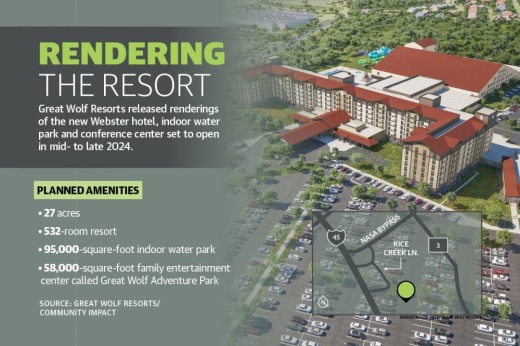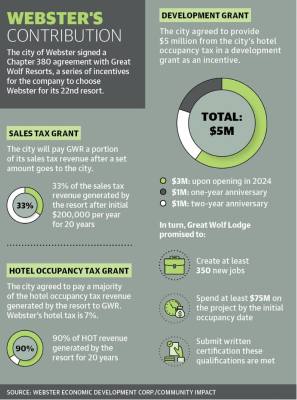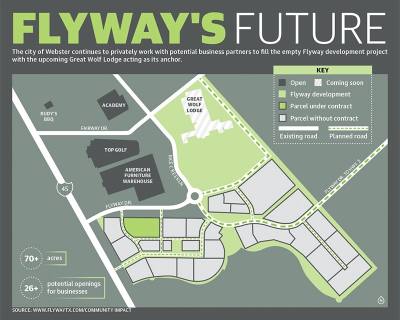Once built, the development east of the Gulf Freeway and south of the NASA Bypass is expected to boost the tourism economy for the Houston Bay Area and bring 500 permanent full- and part-time jobs to the Webster community while also drawing in new businesses for the city’s ambitions to build a destination development.
“This is the largest and most important project in our city’s history,” Webster Mayor Donna Rogers said. “I am so grateful for the Great Wolf Resorts team and the Webster teams who got us to the finish line to celebrate what will be the only Great Wolf Lodge indoor waterpark resort, hotel and conference center in the entire Houston metropolitan statistical area.”
GWR CEO Murray Hennessy said at the lodge’s Sept. 22 groundbreaking ceremony that the construction, which is estimated to employ more than 600 workers, will take roughly 24 months, and the resort is expected to open in mid- to late 2024.
Hennessy said the process for determining the location of the 22nd Great Wolf Lodge began in Texas, which is home to one lodge in Grapevine in the Dallas-Fort Worth metro area. He said the company then narrowed it down to the Houston area based on its demographics and population size and eventually chose Webster due to the details of their partnership.
“[Webster] helped us overcome obstacles,” Hennessy said. “These are complicated projects to do. You need a good working relationship, and they were wonderful partners. That’s what made a difference.”
The lodge will feature a 532-room resort, a 95,000-square-foot indoor water park, a 58,000-square-foot entertainment center called the Great Wolf Adventure Park and a 11,000-square-foot conference center.
The new Great Wolf Lodge will be the first “Generation 4” lodge the company has built, Hennessy said. A Generation 4 resort is an amalgamation of the most successful attractions and ideas from previous resorts as well as being generally larger than other lodges, he said.
“We put the latest and greatest [attractions] in the latest generation. This one will have a slightly larger waterpark than most of our waterparks. It will have more dry play activities and more food and beverage options,” Hennessy said. “The specifics of what’s in there will just be the latest things that have worked the best.”
Webster’s incentive package
In October 2021, the Webster Economic Development Corp. signed an agreement with Great Wolf Resorts. The agreement detailed how the city incentivized the company to select Webster for its next resort and assist in its construction and operation, including building roads to accommodate development.
Webster Economic Development Director Betsy Giusto said tourism is a top economic driver for the city, and the Great Wolf Lodge is another piece of the puzzle for attracting visitors.
“We’re literally paving the way; you can see the road lanes,” Giusto said. “The Webster way is to be business friendly.”
The city’s incentive package consisted of paying the company $5 million from Webster’s hotel occupancy tax fund, or money collected from taxing the cost of staying at a hotel in the city; reimbursing the lodge’s building permit fee of $500,000; purchasing an environmental insurance policy for $153,000; and giving 29 acres of land plus access roads for the resort at no cost to GWR.
The agreement states GWR will receive 90% of the city’s portion of hotel tax revenue collected from the resort for 20 years. Additionally, the city will provide GWR 33% of the sales taxes it generates for 20 years after Webster retains the first $200,000 each year. The city’s hotel and sales taxes are set at 7% and 2%, respectively.
These incentives are based on Chapter 380 from the Texas Local Government Code, which allows the city of Webster to offer incentives for prospective businesses to promote economic development and stimulate business or commercial activity.
The agreement states the lodge “is a key component and is critical to the success of the destination development,” referring to the Flyway project.Steve Jacobsen, GWR vice president of domestic development, said the city’s incentive package is based on the economic performance of the resort, such as the city offering GWR the majority of the hotel tax revenue generated by the resort.
“As we do better, the county does better,” Jacobsen said. “A lot of the grants are for infrastructure. ... The city is building the main road, and those kinds of things are public improvements.”
Jacobsen said the resort’s expected profitability depends on a variety of factors, such as the typical household incomes and age demographics in an area, which guided officials in their selection of Webster for the new resort. He declined to provide estimates relating to the economic impact of the new resort.
“We look anywhere between the third and the fifth year as our stabilized year, and so it’s important to see if you can get the hotel tax sharing to coincide with that kind of framework,” Jacobsen said. “There’s a lot of negotiations back and forth; you know, there’s no free lunch in this world.”
Flyway and the bigger picture
The new Great Wolf Lodge is commonly referred to as the “anchor” for Webster’s upcoming destination development Flyway, which is in the early stages of planning as the city works to fill the planned space with new business partners.
“We’re not part of the Flyway development officially, but we will become an anchor,” Hennessy said. “Businesses come in a lot and set up around us as we are bringing thousands of visitors every week. And in addition, we have a conference center bringing in businesses as well.”
The more than 70-acre Flyway development will include entertainment, dining, recreation and sports entertainment venues, according to a statement from the city of Webster shown to Community Impact by Webster Marketing and Tourism Specialist Kathryn Vela.
The statement reads the WEDC team is actively recruiting entertainment venues, restaurants and bars and that “premier venues will be announced soon.” City officials declined to provide a timeline on the construction for the project. Giusto said the city expects additional areas of the Flyway development will be under contract before the end of the fourth quarter of 2022.
“This is going to be such a walkable development,” Giusto said. “Flyway is going to be a place for people to come and spend a lot of time here. And Great Wolf Lodge—who could ask for better hospitality?”
Dan Seal, executive director of economic development at the Bay Area Houston Economic Partnership, said the search for potential business partners at Flyway is highly competitive. He said he was not able to elaborate on his knowledge of specific business deals at the development due to confidentiality agreements.
“They’re not only looking at this area, but they’re also looking at other cities in Texas. They’re also looking at other states,” he said.
Seal said the Great Wolf Lodge in Webster will be a pivotal link in the chain of tourism activities featured in the Bay Area.
He said BAHEP is working to shift the area from one-day visits into three-day visits for tourists, saying that the new resort and Flyway will help build a “critical mass” where there is enough tourism and entertainment activities going on so more families could spend a long weekend in the Bay Area.
“Look at Anaheim with Disneyland, or look at Orlando with Disney World, and look at all of the other amusement attractions that tend to cluster together,” Seal said. “Well, we’re seeing that same thing happening here with Space Center Houston, with the Kemah Boardwalk, with all the great restaurants that we have here.”
Seal emphasized the importance of the lodge’s conference center, saying it helps change the dynamic in the Bay Area’s tourism sphere from purely family-related tourism.
He said the impact of the resort will be seen broadly across the Bay Area, including with cruise lines in Galveston and BAHEP’s airline partners Southwest and United Airlines.
“If you think of an entire tourism ecosystem, you’re starting to get the right mindset,” Seal said. “A lot of different players in that industry will benefit.”







